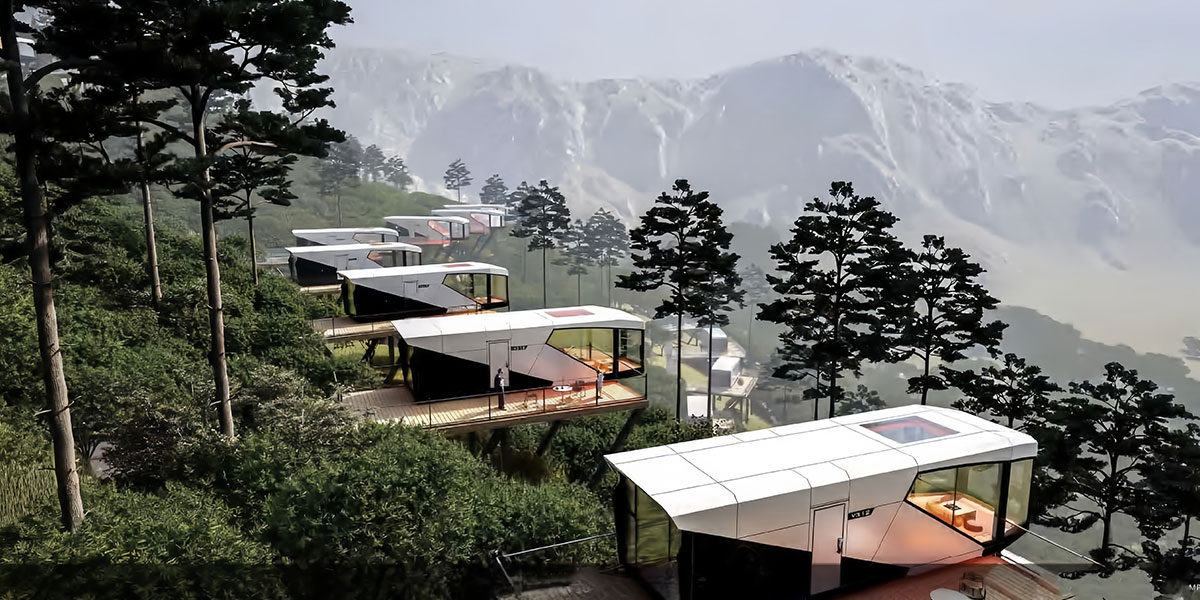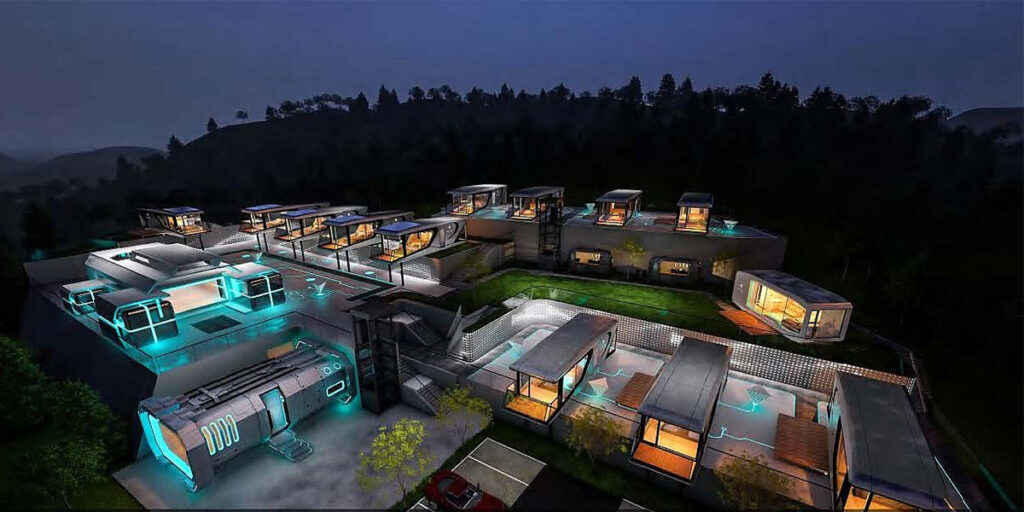
05 Jul Why Capsule Tiny Houses Are Perfect for Eco-Friendly Resorts
Table of Contents
Eco-friendly resorts are changing how we think about travel, and the Capsule Tiny House Resort is a big part of this change. Their small size uses less energy for heat, air, and lights, making them great for resorts wanting to cut pollution. Capsule tiny houses are also made from renewable materials, which helps the planet. A study says 81% of travelers want eco-friendly places to stay. Resorts like the Capsule Tiny House Resort give people this choice while still feeling modern and cozy. These resorts attract eco-friendly guests and set an example for responsible travel.
Key Takeaways
Capsule tiny houses use less power, so they save energy and money.
Green materials like bamboo and reused wood help the planet and create special places to stay.
Off-grid tools, like solar panels and rainwater systems, let resorts work far from cities without needing public utilities.
Capsule houses are cheap to build and easy to take care of, giving resort owners good profits.
Cool features and smart designs make guests comfy, attracting eco-friendly and tech-loving travelers.
Eco-Friendly Features of Capsule Houses
Minimal Energy Use
Capsule houses are built to use less energy. Their small size means less heating, cooling, and lighting are needed. This helps save energy and makes them eco-friendly. Many designs use smart tools like LED lights and smart thermostats. These tools keep guests comfy while cutting down on energy use.
The small size also means better insulation. This keeps heat inside during winter and keeps it cool in summer. Using less energy is good for the planet and saves money for resort owners.
Sustainable Building Materials
Capsule houses are made with materials that are good for the Earth. For example, they often use wood, recycled parts, and special composites. These materials are better for nature and look nice too.
How It’s Sustainable | Why It’s Better for Nature | |
|---|---|---|
Wood | Comes from plants | Less harmful than non-renewable materials |
Composite | Lightweight and strong | Uses eco-friendly fibers in its structure |
Materials like bamboo and certified wood help forests stay healthy. Bamboo grows fast and fights germs naturally. Certified wood comes from forests that are cared for responsibly. Recycled materials, like old wood or metal, cut waste and make each house unique. Choosing these materials helps the planet and gives guests a cozy, green place to stay.
Checking how materials affect the environment over time can help resorts improve. This process, called life-cycle assessment, shows how to make better choices for the planet.
Off-Grid Living
Capsule houses are great for living without regular utilities. Many have solar panels and wind turbines for power. For example, the EcoCapsule uses solar panels and a wind turbine to make energy. It also has a battery to store power for cloudy or calm days.
Some capsule houses collect and clean rainwater. The EcoCapsule, for instance, has tanks that hold and filter rainwater. These features let resorts run in faraway places without needing city utilities.
Using off-grid capsule houses helps create eco-friendly resorts. Guests will love the creative design, and owners will save money on utilities. Plus, it’s better for the environment.
Cost Advantages of Capsule Tiny House Resorts

Affordable Construction and Maintenance
Building capsule houses costs much less than regular homes. Their small size and simple design save money on materials and labor. For example, a capsule house costs $20,000 to $100,000. Regular homes often cost more than $200,000. Building a capsule house takes weeks, not months or years like bigger homes.
Aspect | Capsule Tiny House | Traditional Home |
|---|---|---|
Upfront Cost | $20,000 – $100,000 | Over $200,000 |
Construction Time | Weeks | Months to over a year |
Ongoing Expenses | Lower utility bills | Higher utility bills |
Labor Costs | Lower | Higher |
Capsule houses are also cheaper to maintain. Their small size means fewer repairs and lower upkeep costs. Energy-saving tools like LED lights and smart thermostats cut utility bills by up to 30%. These savings make capsule houses a smart and affordable choice for eco-friendly resorts.
Efficient Space Utilization
Capsule houses use every bit of space wisely. They are usually 50 to 100 square feet. Smart designs and furniture make sure no space is wasted. Foldable beds, built-in storage, and multi-use furniture make them cozy and useful.
Bigger tiny houses (100 to 400 square feet) often have empty spaces. This leads to higher energy and maintenance costs. Capsule houses, with their smart layouts, are better for resorts. They save money and give guests a comfy, organized place to stay.
Financial Viability for Resort Owners
Capsule houses are a great investment for resort owners. They cost less to build and maintain. Energy-saving systems help cut utility bills by up to 25%.
The return on investment (ROI) for capsule resorts is 15% to 25%. This depends on location, guest numbers, and costs. Capsule houses attract eco-friendly travelers looking for unique stays.
Choosing capsule houses helps resorts save money and protect the planet. They are a smart choice for both owners and guests.
Guest Experience in Capsule Houses
Privacy and Comfort
Capsule houses give both privacy and comfort to guests. Their small size creates a personal space for relaxing. Unlike regular hotel rooms, they block noise and distractions. This makes them peaceful and cozy places to stay.
The design focuses on making guests feel comfortable. Soundproof walls and comfy furniture improve the experience. These features make capsule houses great for quiet getaways. Whether traveling alone or with someone special, you’ll enjoy the privacy and comfort they offer.
Modern Amenities
Capsule houses come with modern features to improve your stay. Many have smart tools like self-check-ins, smart pods, and fast Wi-Fi. These are perfect for tech-loving travelers who want convenience.
Studies show guests care about hotel services and amenities. These are key to their happiness with eco-friendly stays.
Travelers aged 25-39 are choosing capsule hotels more often. They want affordable and tech-friendly places to stay. Smart thermostats and energy-saving devices make the stay better. These also match eco-friendly goals.
Common modern features in capsule houses:
Self-check-ins
Smart pods with adjustable lights
Fast internet for remote workers
These features make capsule houses a smart and fun choice for guests.
Connection to Nature
Capsule houses help you feel closer to nature. Their small size lets resorts place them in beautiful spots. Big windows and open designs give amazing views from inside.
Many capsule houses use eco-friendly designs that fit into nature. They may have solar panels and systems to collect rainwater. You can wake up to birds singing or sleep under the stars.
Capsule houses mix modern living with the beauty of nature. This balance makes your stay special and unforgettable.
Market Appeal of Capsule Tiny House Resorts
Attracting Eco-Conscious Travelers
If you care about the Earth, these resorts are perfect. Capsule tiny house resorts focus on being green and saving energy. They use renewable materials and can work without city utilities. Staying here means you’re helping eco-friendly tourism grow.
People who love the planet want places that match their values. Capsule houses lower pollution and support green living. Resorts using these ideas attract travelers who want to help the environment.
Appealing to Minimalist and Tech-Savvy Guests
These resorts are great for people who like simple living. Capsule houses are small but designed to use space wisely. They feel calm and free of clutter, which many enjoy.
Tech lovers will also like the smart features in these houses. Things like keyless doors, smart lights, and climate controls make life easier. If you enjoy technology and simple designs, you’ll love staying here.
Unique and Memorable Experiences
Capsule tiny house resorts offer more than just a bed. They give you a special and unique stay. Their small size lets them sit in beautiful natural spots. You could wake up to views of mountains or beaches.
These resorts mix nature with modern comforts. The eco-friendly designs and amazing locations make your trip unforgettable. They’re perfect for adventure, peace, and caring for the planet.
Capsule tiny houses mix eco-friendliness, low cost, and guest happiness. They are small, modern, and fit well in great locations.
Benefit | Description |
|---|---|
Budget-Friendly | Capsule houses cost 50-70% less than regular hotels. |
Modern Features | They include Wi-Fi, air conditioning, and fun extras in a small space. |
Peaceful and Cozy | Guests get private spaces, with 85% loving the quiet and comfort. |
Using capsule tiny houses helps eco-friendly travelers and keeps up with the demand for unique, green vacations.
FAQ
Why are capsule tiny houses good for the environment?
Capsule houses use eco-friendly materials like bamboo and recycled wood. Their small size means they need less energy for heating and cooling. Many have solar panels and systems to collect rainwater, which helps the planet.
Can capsule tiny houses be used far from cities?
Yes, they can! Capsule houses can work off-grid with solar panels, wind turbines, and water filters. These features make them great for resorts in remote areas. You can enjoy nature without needing city utilities.
Are capsule tiny houses comfy for guests?
Yes, they are! Capsule houses use smart designs to save space. They have modern features like Wi-Fi, climate control, and soundproof walls. Guests feel cozy and relaxed during their stay.
How much does it cost to build a capsule tiny house?
Building a capsule house costs $20,000 to $100,000. This is much cheaper than regular homes, which cost over $200,000. Their small size also means lower upkeep and utility costs.
Who would enjoy staying at capsule tiny house resorts?
These resorts are perfect for eco-friendly travelers, minimalists, and tech lovers. If you like green living, modern gadgets, and unique stays, you’ll love them!



